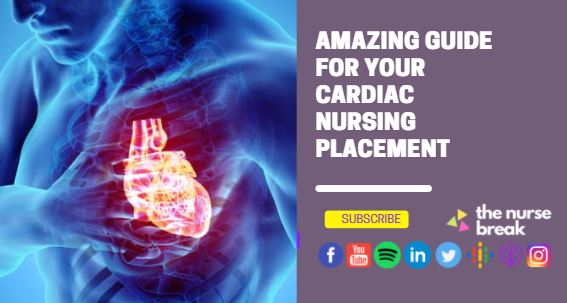Table of Contents
How to ace a cardiac nursing placement
The following will cover a collection of general tips! We suggest you read this article in combination with Some other articles you will enjoy- For a comprehensive and systematic approach to assessment in ICU, read THIS POST
- Cheat-sheet guide for your ICU nursing placement HERE
- For a guide to placement/grad year on a cardiac / cardiothoracics ward + free worksheet on cardiac pharmacology and main cardiac issues go HERE
- The ultimate nursing guide to sepsis
- A cheat-sheet guide for your cardiac nursing placement
- The helpful complete guide to an Aged Care Nursing Placement for students
- 14 strategies for successful clinical placements
- Untangling nursing communication – “My patient can’t talk to me… Help!”
- Step-by-step explanation of nursing CPD
- Helpful list of proven graduate nurse tips!
- You MUST know about ACT-PINCHES (N) drugs
General Tips
Please note…this is a brief outline of SOME relevant content. We don’t go providing links and answers to all questions. It is much more valuable to have you do the research on your own, this will make you a better learner, and better practitioner. This aims to hopefully guide you in the right direction.- Anatomy and Physiology of the heart and lungs and assosciated core drugs (you’re welcome…the download file above helps you). Also pick up your textbook and read these chaptors. This includes
- Know the correct route of blood in the heart – (what is correct order?) Tricuspid Valve, Pulmonic Valve, Pulmonary Circulation, Mitral Valve, Aortic Valve. Blood enters the heart through two large veins, the inferior and superior vena cava, emptying oxygen-poor blood from the body into the right atrium. –>> Now you need to learn the rest….
- The main cardiac conditions (as seen in the downloadable file above)
- Know when and when NOT to give medications. Check out these 100% must have resources
- Interpretation of ECGs, you’ll also probably have heaps of patients on telemetry.
- Your shockable and non shockable rhythms.
- Read up on Advanced Life Support flowchart – because in a cardiac arrest / code blue this is the system that the ALS nurses and doctors will use. You may as well begin to learn the process and understand what and why they do certain things!
- Read up on pacing and PPMs (Permanent Pacemakers)
- Thorough head to toe assessment skills (always listen to the heart). Practice how you would perform it and understand what you’re listening for and what’s normal and abnormal. Check out this link to learn and hear all about lung and heart sounds
- Post – surgical areas always has lots of regional blocks, PCA’s, drain tubes, ICC’s, wounds (mediastinal, radial, femoral)
- Normal ranges for pathology results including ABGs and VBGs
- Understand each of these and why the medical team would want them/what are they looking for? ABG, UEC, LFT, CMP, FBC, COAG, CKMB, Troponin, CXR
- Read the hospitals policy on chest pain management
- Read up on ‘third spacing’, redistribution of fluid and electrolytes from the intravascular space to the interstitial compartment can occur after cardiac/thoracic surgeries
- Be prepared to do lots of venepuncture
- Read up on significance of Mean Arterial Pressure. Our ICU placement guide has some links






Thankyou for this excellent structured content. Will surely guide me through the maze.
NOTE: The Heart Anatomy image from wiki above has Right Pulmonary Artery pointing to Superior Vena Cava.